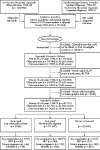Incidence of severe reproductive tract complications associated with diagnosed genital chlamydial infection: the Uppsala Women's Cohort Study
- PMID: 16731670
- PMCID: PMC2576723
- DOI: 10.1136/sti.2005.017186
Incidence of severe reproductive tract complications associated with diagnosed genital chlamydial infection: the Uppsala Women's Cohort Study
Abstract
Objective: To estimate the cumulative incidence of severe complications associated with genital chlamydia infection in the general female population.
Methods: The Uppsala Women's Cohort Study was a retrospective population based cohort study in Sweden, linking laboratory, hospital, and population registers. We estimated the cumulative incidence of hospital diagnosed pelvic inflammatory disease, ectopic pregnancy, and infertility, and used multivariable regression models to estimate hazard ratios according to screening status.
Results: We analysed complete data from 43 715 women in Uppsala aged 15-24 years between January 1985 and December 1989. Follow up until the end of 1999 included 709 000 woman years and 3025 events. The cumulative incidence of pelvic inflammatory disease by age 35 years was 3.9% (95% CI 3.7% to 4.0%) overall: 5.6% (4.7% to 6.7%) in women who ever tested positive for chlamydia, 4.0% (3.7% to 4.4%) in those with negative tests, and 2.9% (2.7% to 3.2%) in those who were never screened. The corresponding figures were: for ectopic pregnancy, 2.3% (2.2% to 2.5%) overall, 2.7% (2.1% to 3.5%), 2.0% (1.8% to 2.3%), and 1.9% (1.7% to 2.1%); and for infertility, 4.1% (3.9% to 4.3%) overall, 6.7% (5.7% to 7.9%), 4.7% (4.4% to 5.1%), and 3.1% (2.8% to 3.3%). Low educational attainment was strongly associated with the development of all outcomes.
Conclusions: The incidence of severe chlamydia associated complications estimated from ours, and other population based studies, was lower than expected. Studies that incorporate data about pelvic inflammatory disease diagnosed in primary care and behavioural risk factors would further improve our understanding of the natural history of chlamydia. Our results provide reassurance for patients, but mean that the benefits of chlamydia screening programmes might have been overestimated.
Conflict of interest statement
Conflict of interest: none declared.
References
-
- Cates W, Jr, Wasserheit J N. Genital chlamydial infections: epidemiology and reproductive sequelae. Am J Obstet Gynecol 19911641771–1781. - PubMed
-
- Weström L. Effect of acute pelvic inflammatory disease on fertility. Am J Obstet Gynecol 1975121707–713. - PubMed
-
- Health Protection Agency Chlamydia. http://www.hpa.org.uk/infections/topics_az/hiv_and_sti/sti‐chlamydia/chl..., 2005. Accessed 5 July 2005
Publication types
MeSH terms
LinkOut - more resources
Full Text Sources
Medical


